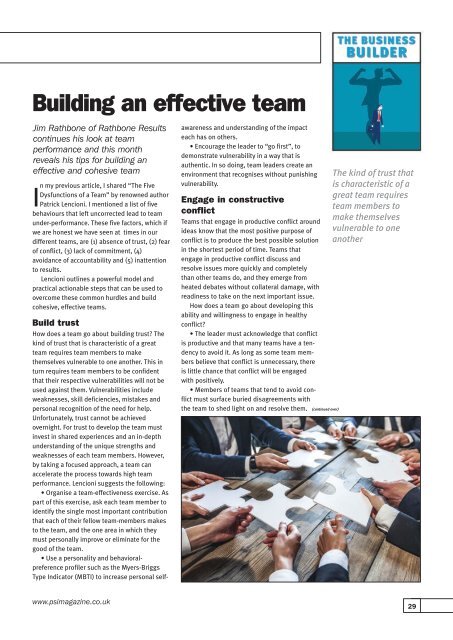PSINovember2017
Create successful ePaper yourself
Turn your PDF publications into a flip-book with our unique Google optimized e-Paper software.
Building an effective team<br />
Jim Rathbone of Rathbone Results<br />
continues his look at team<br />
performance and this month<br />
reveals his tips for building an<br />
effective and cohesive team<br />
n my previous article, I shared “The Five<br />
IDysfunctions of a Team” by renowned author<br />
Patrick Lencioni. I mentioned a list of five<br />
behaviours that left uncorrected lead to team<br />
under-performance. These five factors, which if<br />
we are honest we have seen at times in our<br />
different teams, are (1) absence of trust, (2) fear<br />
of conflict, (3) lack of commitment, (4)<br />
avoidance of accountability and (5) inattention<br />
to results.<br />
Lencioni outlines a powerful model and<br />
practical actionable steps that can be used to<br />
overcome these common hurdles and build<br />
cohesive, effective teams.<br />
Build trust<br />
How does a team go about building trust? The<br />
kind of trust that is characteristic of a great<br />
team requires team members to make<br />
themselves vulnerable to one another. This in<br />
turn requires team members to be confident<br />
that their respective vulnerabilities will not be<br />
used against them. Vulnerabilities include<br />
weaknesses, skill deficiencies, mistakes and<br />
personal recognition of the need for help.<br />
Unfortunately, trust cannot be achieved<br />
overnight. For trust to develop the team must<br />
invest in shared experiences and an in-depth<br />
understanding of the unique strengths and<br />
weaknesses of each team members. However,<br />
by taking a focused approach, a team can<br />
accelerate the process towards high team<br />
performance. Lencioni suggests the following:<br />
• Organise a team-effectiveness exercise. As<br />
part of this exercise, ask each team member to<br />
identify the single most important contribution<br />
that each of their fellow team-members makes<br />
to the team, and the one area in which they<br />
must personally improve or eliminate for the<br />
good of the team.<br />
• Use a personality and behavioralpreference<br />
profiler such as the Myers-Briggs<br />
Type Indicator (MBTI) to increase personal selfawareness<br />
and understanding of the impact<br />
each has on others.<br />
• Encourage the leader to “go first”, to<br />
demonstrate vulnerability in a way that is<br />
authentic. In so doing, team leaders create an<br />
environment that recognises without punishing<br />
vulnerability.<br />
Engage in constructive<br />
conflict<br />
Teams that engage in productive conflict around<br />
ideas know that the most positive purpose of<br />
conflict is to produce the best possible solution<br />
in the shortest period of time. Teams that<br />
engage in productive conflict discuss and<br />
resolve issues more quickly and completely<br />
than other teams do, and they emerge from<br />
heated debates without collateral damage, with<br />
readiness to take on the next important issue.<br />
How does a team go about developing this<br />
ability and willingness to engage in healthy<br />
conflict?<br />
• The leader must acknowledge that conflict<br />
is productive and that many teams have a tendency<br />
to avoid it. As long as some team members<br />
believe that conflict is unnecessary, there<br />
is little chance that conflict will be engaged<br />
with positively.<br />
• Members of teams that tend to avoid conflict<br />
must surface buried disagreements with<br />
the team to shed light on and resolve them.<br />
(continued over)<br />
The kind of trust that<br />
is characteristic of a<br />
great team requires<br />
team members to<br />
make themselves<br />
vulnerable to one<br />
another<br />
www.psimagazine.co.uk<br />
29

















